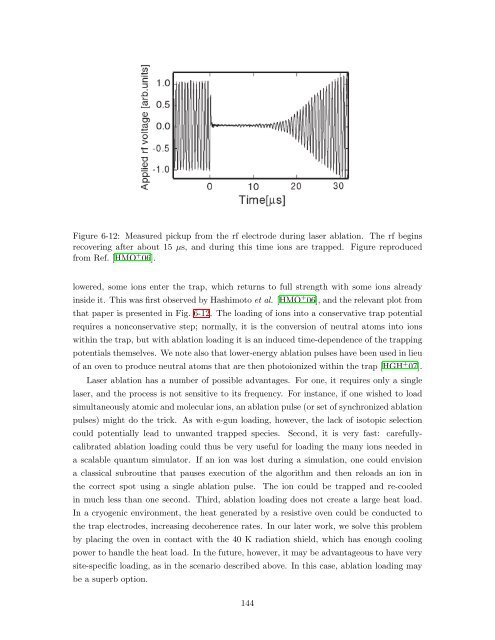Ph.D. Thesis - Physics
Ph.D. Thesis - Physics
Ph.D. Thesis - Physics
You also want an ePaper? Increase the reach of your titles
YUMPU automatically turns print PDFs into web optimized ePapers that Google loves.
Figure 6-12: Measured pickup from the rf electrode during laser ablation. The rf begins<br />
recovering after about 15 µs, and during this time ions are trapped. Figure reproduced<br />
from Ref. [HMO + 06].<br />
lowered, some ions enter the trap, which returns to full strength with some ions already<br />
inside it. This was first observed by Hashimoto et al. [HMO + 06], and the relevant plot from<br />
that paper is presented in Fig. 6-12. The loading of ions into a conservative trap potential<br />
requires a nonconservative step; normally, it is the conversion of neutral atoms into ions<br />
within the trap, but with ablation loading it is an induced time-dependence of the trapping<br />
potentials themselves. We note also that lower-energy ablation pulses have been used in lieu<br />
of an oven to produce neutral atoms that are then photoionized within the trap [HGH + 07].<br />
Laser ablation has a number of possible advantages. For one, it requires only a single<br />
laser, and the process is not sensitive to its frequency. For instance, if one wished to load<br />
simultaneously atomic and molecular ions, an ablation pulse (or set of synchronized ablation<br />
pulses) might do the trick. As with e-gun loading, however, the lack of isotopic selection<br />
could potentially lead to unwanted trapped species. Second, it is very fast: carefully-<br />
calibrated ablation loading could thus be very useful for loading the many ions needed in<br />
a scalable quantum simulator. If an ion was lost during a simulation, one could envision<br />
a classical subroutine that pauses execution of the algorithm and then reloads an ion in<br />
the correct spot using a single ablation pulse. The ion could be trapped and re-cooled<br />
in much less than one second. Third, ablation loading does not create a large heat load.<br />
In a cryogenic environment, the heat generated by a resistive oven could be conducted to<br />
the trap electrodes, increasing decoherence rates. In our later work, we solve this problem<br />
by placing the oven in contact with the 40 K radiation shield, which has enough cooling<br />
power to handle the heat load. In the future, however, it may be advantageous to have very<br />
site-specific loading, as in the scenario described above. In this case, ablation loading may<br />
be a superb option.<br />
144
















